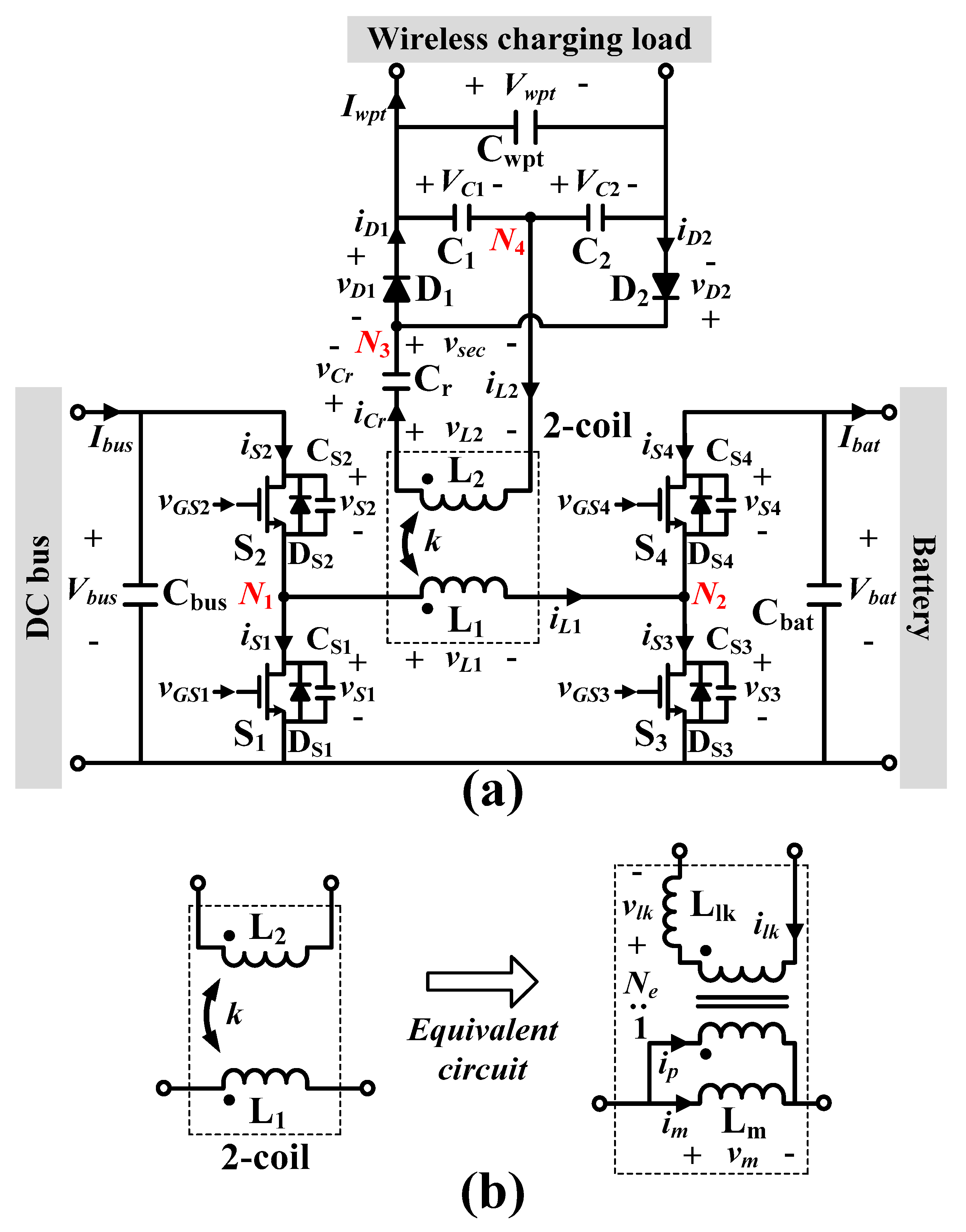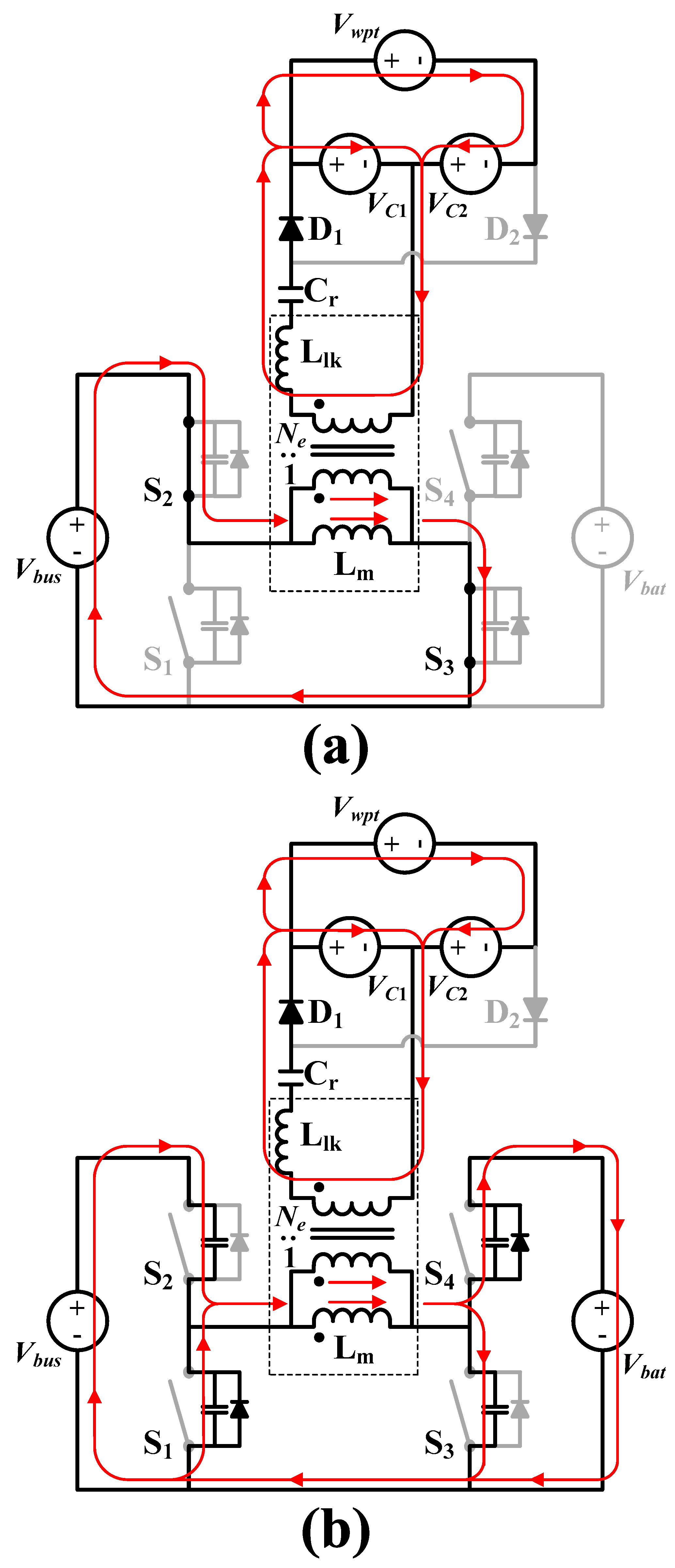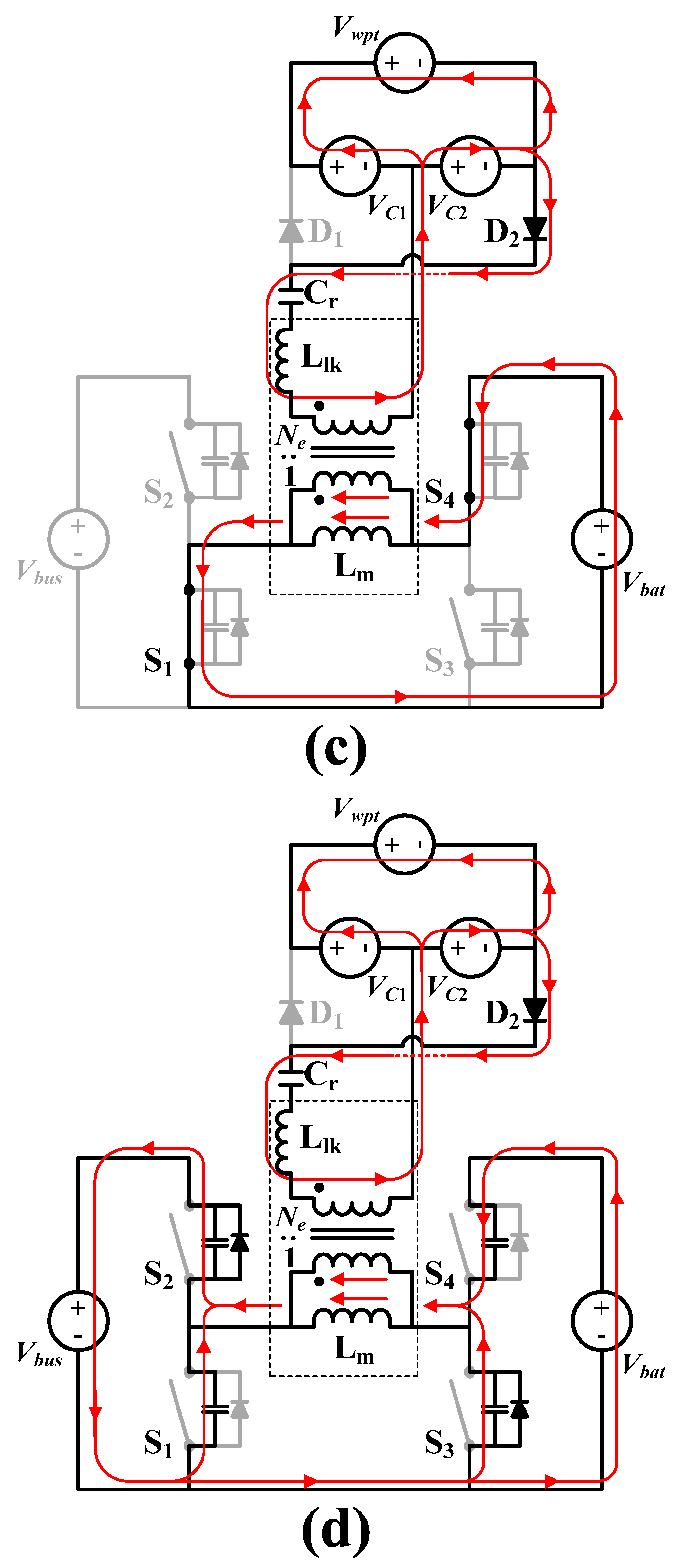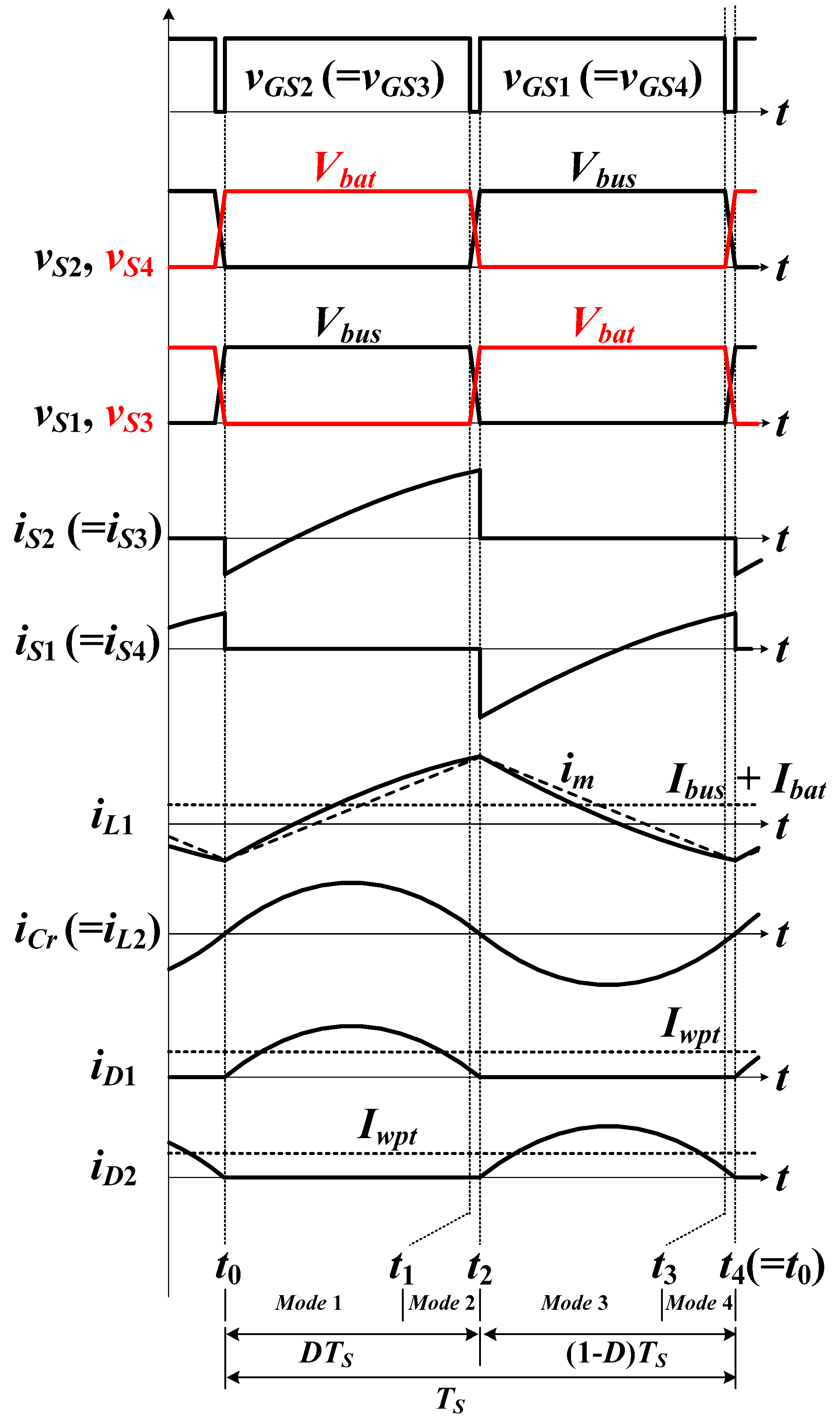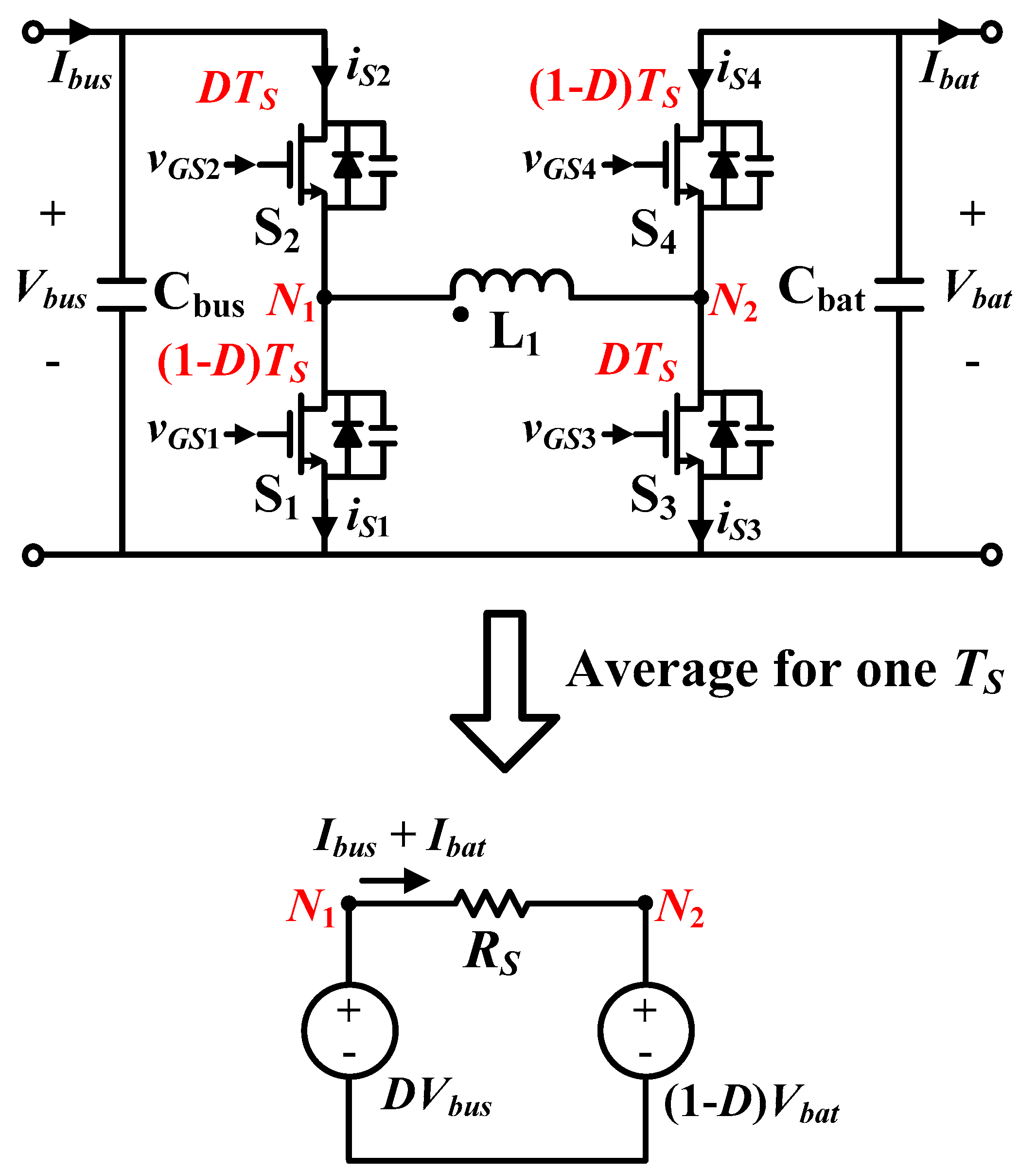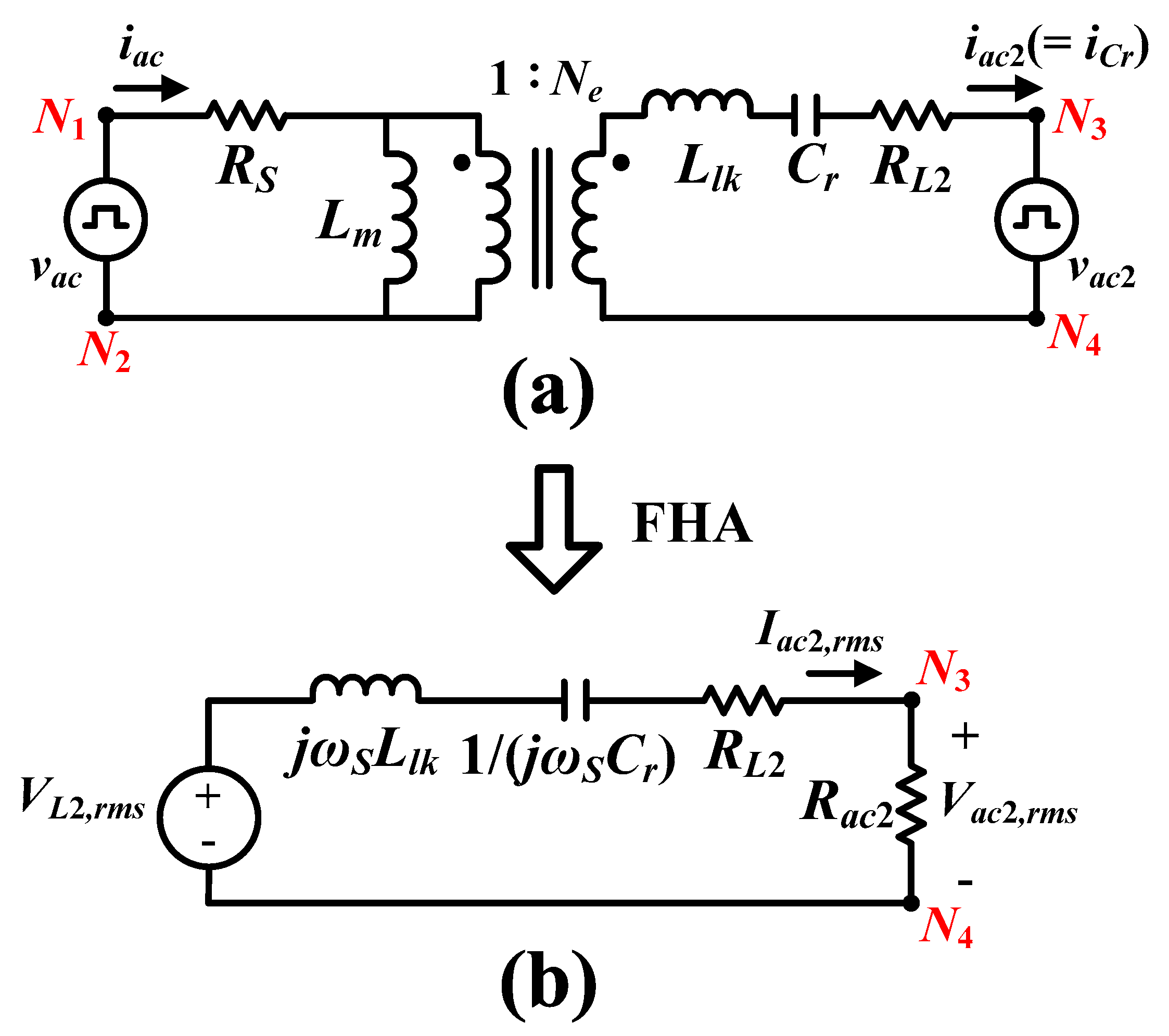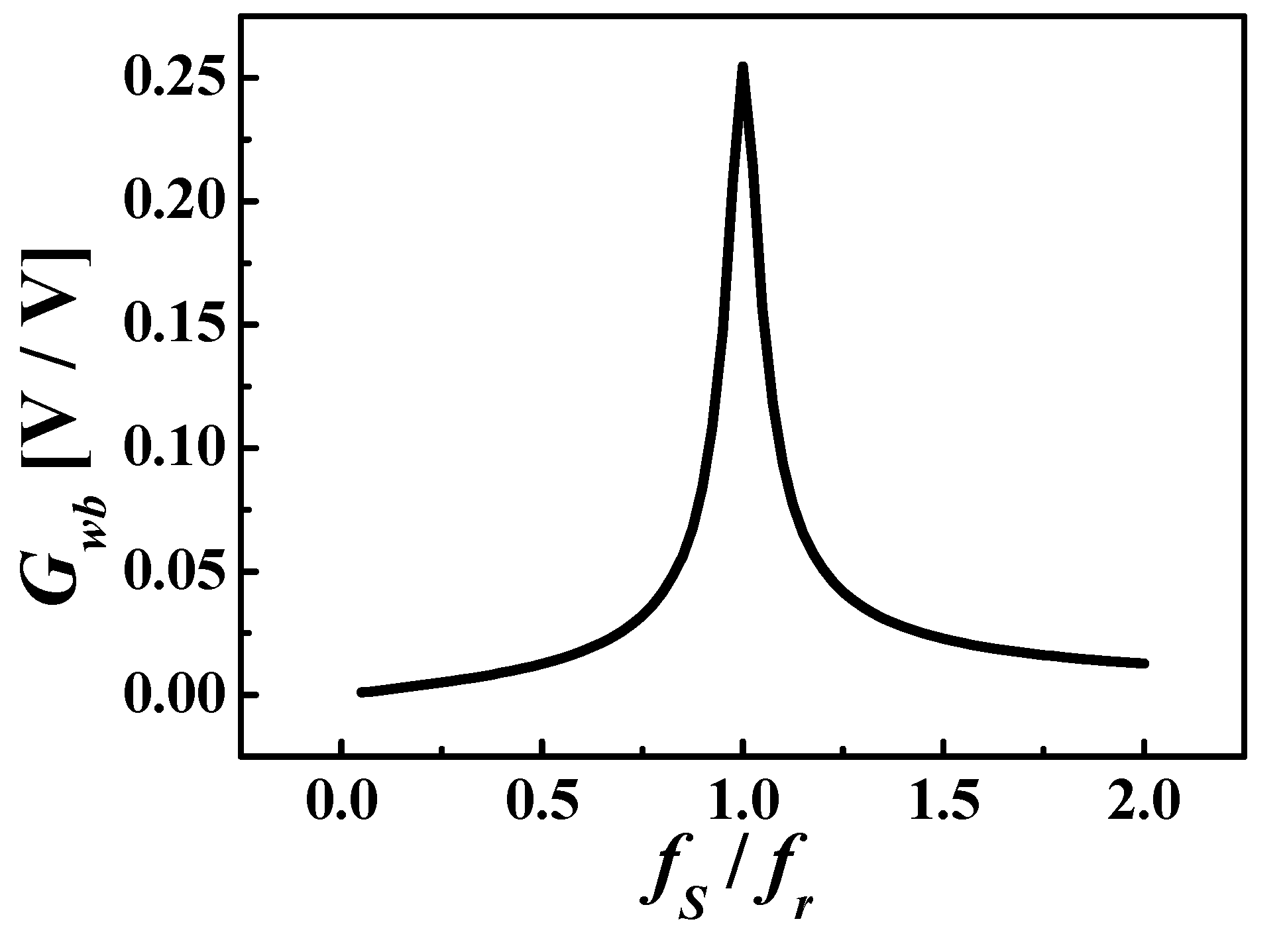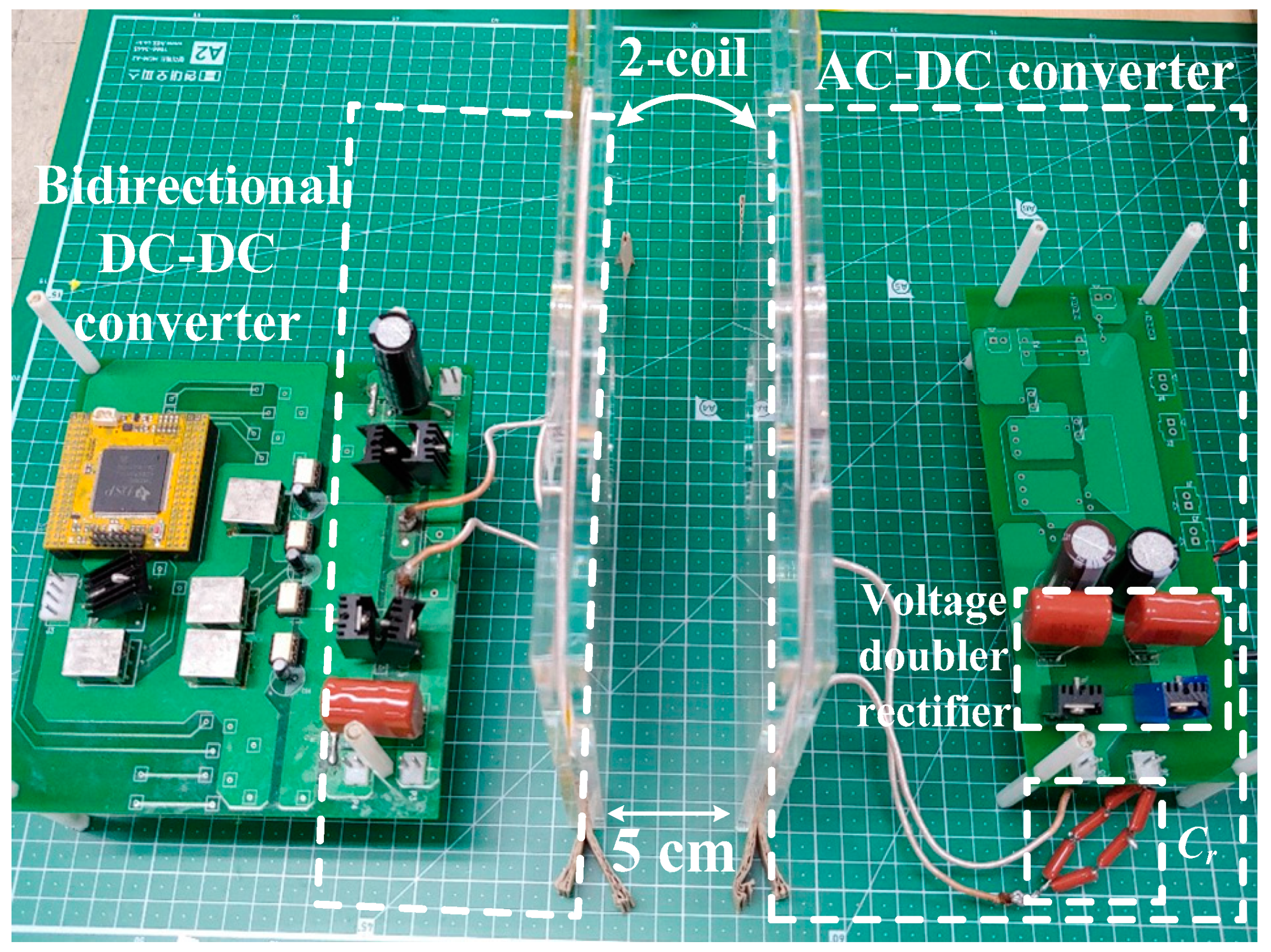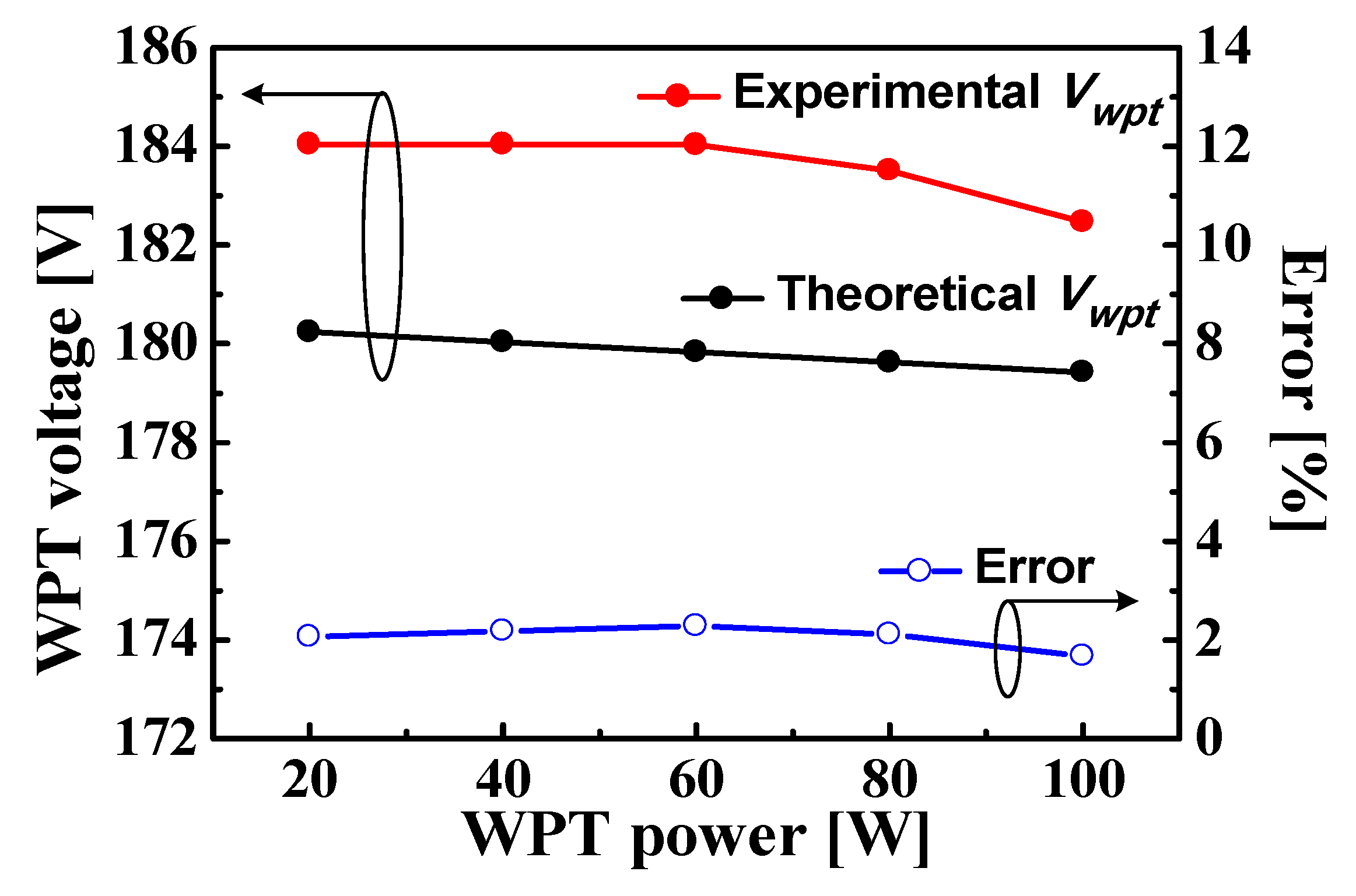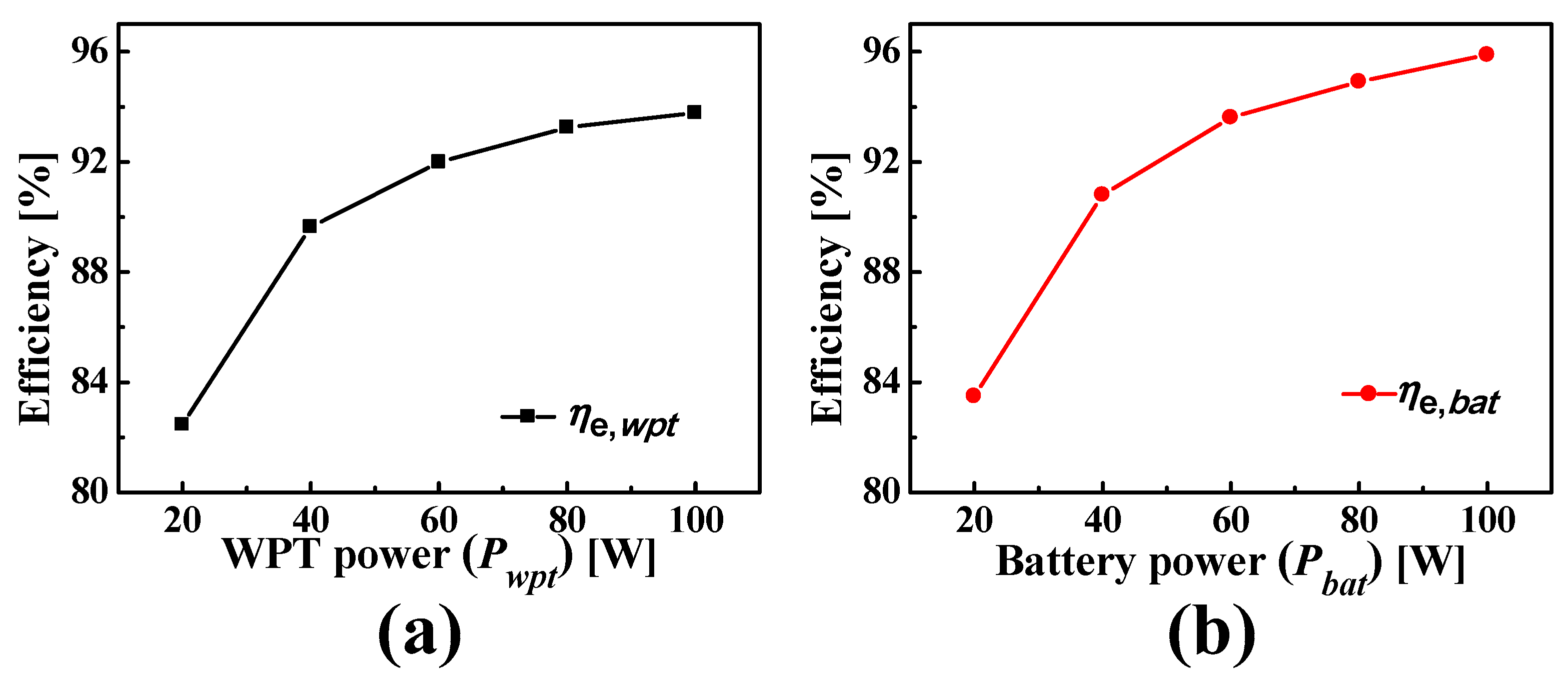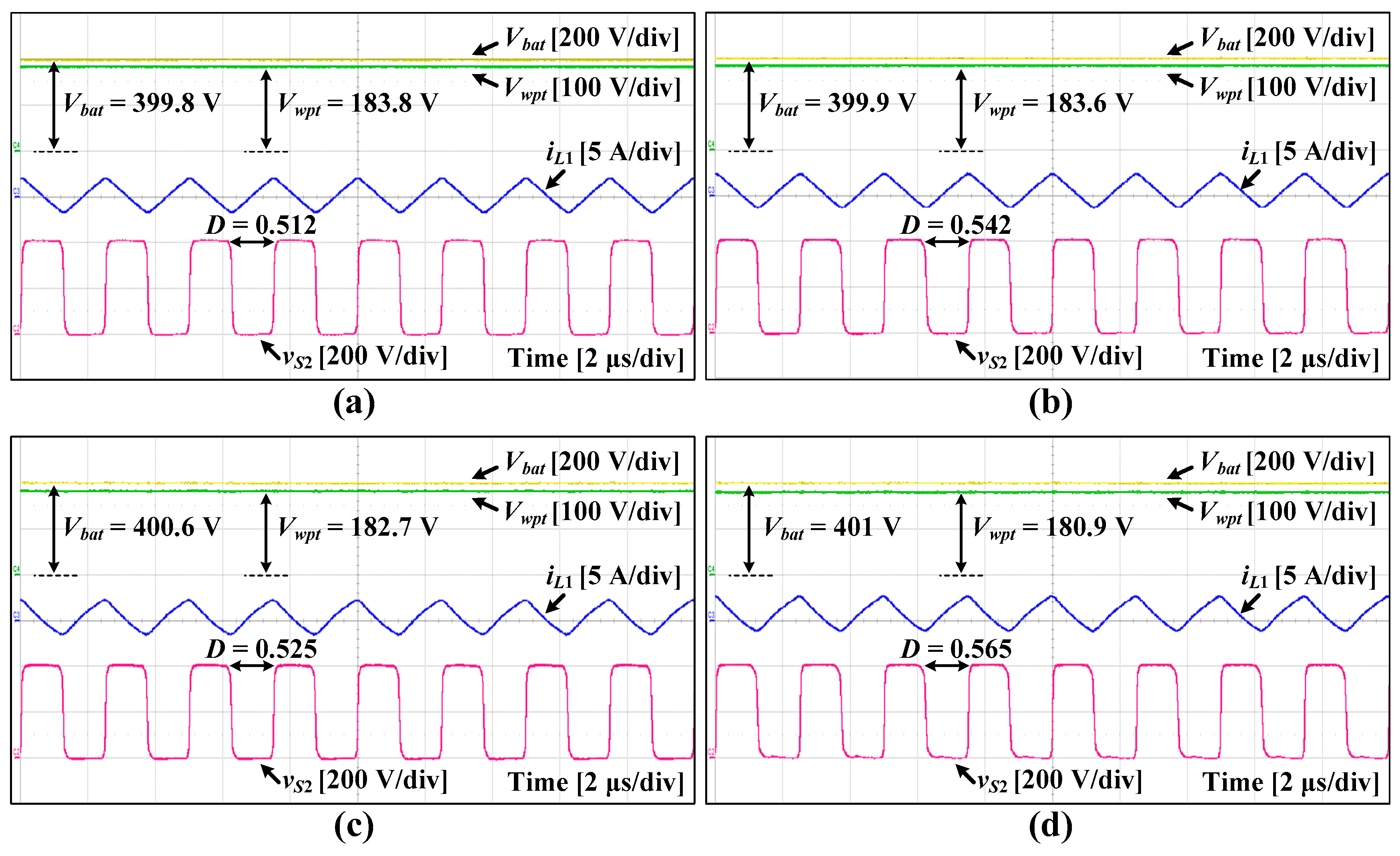1. Introduction
Photovoltaics (PVs) constitute a promising alternative energy source due to diverse applications and the ubiquity of sunlight [
1,
2,
3,
4]. Residential PV systems consist of a PV module and a PV inverter, and it converts sunlight into electricity. However, energy output by PV systems is not constant because it is affected by weather conditions and the day/night cycle. Therefore, energy storage (ES) systems are used to efficiently manage the PV energy. They consist of a battery and a bidirectional DC-DC converter that connects to the PV system [
5,
6,
7]. Besides, in the near future, the wireless power transfer (WPT) systems will be widely used to wirelessly charge laptops as well as cell phones in many households [
8,
9,
10,
11]. Therefore, future PV energy delivery and management infrastructure for residential applications will consist of PV systems, ES systems, and WPT systems (
Figure 1a).
Three-port converters have been used to reduce the cost and size of infrastructure, such as micro-grids and smart grids [
12,
13,
14,
15,
16,
17,
18]. The infrastructure consists of several systems, so its cost and size increase in proportion to the number of systems. To alleviate this problem, two systems are integrated through on a three-port converter. The three-port converters usually add a port to a typical converter that has two ports, either by using a three-winding transformer instead of a two-winding transformer [
13,
14,
15] or by using the storage capacitor in the typical converter as a third port [
16,
17,
18].
Many three-port converters have been introduced to integrate renewable energy sources (e.g., PV, fuel cell, wind turbine) with ES systems, but a three-port converter to integrate ES and WPT systems has not been considered. Therefore, this paper presents a three-port converter that can integrate the ES and WPT systems that will be used in future PV energy delivery and management infrastructure for residential applications (
Figure 1b). The proposed three-port converter consists of a bidirectional DC-DC converter for an ES system and an AC-DC converter with a resonant capacitor. The bidirectional DC-DC converter can also operate as a DC-AC converter of the WPT system because the inductor in the bidirectional DC-DC converter is also used as a transmitting coil for a WPT system. With these few components, the proposed converter can store energy for the ES system and simultaneously transfer the energy by using a WPT system. The proposed converter has a high power-conversion efficiency by achieving zero voltage switching (ZVS) turn-on for switches, and has high voltage gain for WPT by using a resonance between a resonant capacitor and a leakage inductance of a receiving coil.
Section 2 describes the circuit structure and operating principles of the proposed converter.
Section 3 presents experimental results, and
Section 4 concludes the paper.
2. Proposed Three-Port Converter
2.1. Circuit Structure
The proposed converter (
Figure 2a) combines the structures of a bidirectional DC-DC converter and an AC-DC converter.
The bidirectional DC-DC converter is located between a DC bus and a battery to transfer the energy in both directions (DC bus ↔ battery). This converter consists of four switches (S1, S2, S3, S4), two filter capacitors (bus capacitor, Cbus, with capacitance, Cbus, and battery capacitor, Cbat, with capacitance, Cbat), and an inductor (L1 with inductance L1). In addition, it can transfer the energy of the DC bus (or battery) to the wireless charging load because L1 also acts as a transmitting coil for WPT.
The AC-DC converter is connected to a wireless charging load, such as a cell phone or laptop, and it has a receiving coil (L2 with inductance L2) for WPT, a filter capacitor (WPT capacitor, Cwpt, with capacitance, Cwpt), a resonant capacitor (Cr with capacitance, Cr), and a voltage doubler rectifier that consists of two diodes (D1, D2) and two doubler capacitors (C1 with capacitance, C1, and C2 with capacitance, C2).
L
1 and L
2 are parts of the two-coil structure; they are coupled magnetically with a coupling coefficient,
k, to transfer the energy wirelessly. Based on [
19,
20], the two-coil structure can be represented as a transformer with a leakage inductor (
Llk with inductance,
Llk), an effective turn ratio (N
e), and a magnetizing inductor (
Lm with inductance,
Lm), where
,
, and
(
Figure 2b).
Four switches achieve the ZVS turn-on by using the stored energy in L1. Llk resonates with Cr, and high voltage gain between the DC bus and wireless charging load is achieved by setting the switching frequency, fS, to the resonant frequency, fr, between Llk and Cr. The voltage doubler rectifier converts AC voltage to DC voltage for wireless charging load, and clamps the reverse voltages of D1 and D2 to WPT voltage, Vwpt.
2.2. Principle of Operation
The proposed converter operates at a fixed switching frequency (fS = 1/TS), where TS is a switching period, and it controls the voltage gain between the DC bus voltage, Vbus, and battery voltage, Vbat, by changing the duty ratios of S1, S2, S3, and S4; the duty ratios of S2 and S3 are defined as D, and the duty ratios of S1 and S4 are defined as 1–D. In addition, the voltage gain between Vbus and Vwpt is adjusted by using Ne.
The equivalent circuits (
Figure 3) and operating waveforms (
Figure 4) were obtained under the following assumptions and conditions: (1) All components are lossless, (2)
C1,
C2,
Cbus,
Cbat, and
Cwpt are large enough to assume that
VC1,
VC2,
Vbus,
Vbat, and
Vwpt are constant voltage sources, (3)
fr =
fS, and (4) the converter operates in a steady state. The converter operates in four modes.
Mode 1 (
Figure 3a,
t0 ≤
t ≤
t1): This mode starts at
t =
t0 when S
2 and S
3 are turned on. At this time, S
2 and S
3 achieve ZVS turn-on because the body diodes, D
S2 and D
S3, of S
2 and S
3 are turned on before
t =
t0. During this mode, the voltage,
vm, of L
m becomes
Vbus, and the current,
im, of L
m is:
where
. C
r has voltage
vCr =
NeVbus −
VC1–
vlk and current
iCr =
ilk, and
iCr(
t0) = 0. Therefore:
where
and
. The current,
iD1, of
D1 is equal to
iCr for
t0 ≤
t ≤
t1.
Mode 2 (
Figure 3b,
t1 ≤
t ≤
t2): At
t =
t1, S
2 and S
3 are turned off, and S
1 and S
4 remain in the off-states to prevent a shoot-through problem. This mode is known as dead time. During this mode, the output capacitance, C
S1, of S
1 discharges from
Vbus to 0, and the output capacitance, C
S2, of S
2 charges from 0 to
Vbus. In addition, the output capacitance, C
S4, of S
4 discharges from
Vbat to 0, and the output capacitance, C
S3, of S
3 charges from 0 to
Vbat. Shortly after the discharging and charging processes are finished, the body diodes, D
S1 and D
S4, of S
1 and S
4 are turned on.
Mode 3 (
Figure 3c,
t2 ≤
t ≤
t3): At
t =
t2, S
1 and S
4 are turned on under ZVS conditions because the body diodes, D
S1 and D
S4, are turned on before
t =
t2. During this mode:
because
vm = −
Vbat.
iCr is obtained using
vCr = −
NeVbat +
VC2 −
vlk and
iCr(
t2) = 0 as:
where
. At
t =
t2, D
2 is turned on, and the current,
iD2, of D
2 is −
iCr.
Mode 4 (
Figure 3d,
t3 ≤
t ≤
t4): S
2 and S
3 remain in the off-states because this mode is the dead time interval. During this mode, C
S2 discharges from
Vbus to 0, and C
S1 charges from 0 to
Vbus. In addition, C
S3 discharges from
Vbat to 0, and C
S4 charges from 0 to
Vbat. Shortly after the discharging and charging processes are finished, D
S2 and D
S3 are turned on.
2.3. Voltage Gain
The proposed converter has one input port (DC bus) and two output ports (battery and wireless charging load). Therefore, it has (Equation (1)) a voltage gain, Gbb, between the DC bus and battery and (Equation (2)) a voltage gain, Gwb, between the DC bus and wireless charging load.
(1) Gbb = Vbat/Vbus
For one
TS, the average voltages of C
bus and C
bat are
Vbus and
Vbat, respectively. Then, the average voltage at node
N1 between
S1 and
S2 is
DVbus, and the average voltage at node
N2 between S
3 and S
4 is given by (1-
D)
Vbat. The average voltage of L
1 is zero due to the volt-second balance law for the inductor, and the average currents of switches are given by <
iS2> = <
iS3> =
Ibus and <
iS1> = <
iS4> = −
Ibat because the average current of the capacitor is zero by the charge balance law. Therefore, the average model of the circuit can be obtained (
Figure 5). In this average model, the series resistance,
RS, is the sum of
RL1 and 2
Ron, where
RL1 and
Ron are a winding resistance of L
1 and on-resistance of a switch, respectively.
By applying Kirchhoff’s voltage law (KVL) to the closed-loop that contains
DVbus,
RS, and (1-
D)
Vbat, the voltage gain
Gbb ( =
Vbat/
Vbus) is obtained as:
where
. In most cases,
, so:
(2) Gwb = Vwpt/Vbus
Based on the four nodes (
N1,
N2,
N3, and
N4) in
Figure 2a, the circuit of the proposed converter can be simplified (
Figure 6a). Here, the square voltage,
vac, between
N1 and
N2 is
Vbus − (
Ibus +
Ibat)
RS for
DTS and −
Vbat − (
Ibus +
Ibat)
RS for (1-
D)
TS. Then, the current
iac is
iL1 − (
Ibus +
Ibat), and the square voltage,
vac2, between
N3 and
N4 becomes
Vwpt/2 for 0.5
TS and −
Vwpt/2 for the other 0.5
TS. The current
iac2 is given by
iCr.
By applying fundamental harmonic approximation (FHA) to
vac,
iac,
iac2, and
vac2, the following root mean square (RMS) values are obtained (
Figure 6b);
VL2,rms is the RMS value of the first harmonic component in the voltage,
vL2, of L
2, and it is given by:
where:
and:
are RMS values of the first harmonic components in
iac2 and
vac2, respectively. Then, the equivalent resistance,
Rac2, between
N3 and
N4 is obtained using Equations (8) and (9) as:
where
. By applying KVL to the closed-loop in
Figure 6b, the relation between
VL2,rms and
Vac2,rms is given by:
where
RL2 is a winding resistance of L
2. Then, substituting Equations (7) and (9) into Equation (11) yields:
If
fr =
fS, maximum
Gwb is obtained because
at
fr =
fS (
Figure 7), and it is given by:
Therefore,
Cr should be chosen to obtain the maximum voltage gain (
Gwb) between
Vbus and
Vwpt. Because
and
,
Cr can be determined as:
2.4. Magnetic Saturation
The coil structure, which consists of a transmitting coil (L
1) and a receiving coil (L
2), can use magnetic bars to increase efficiency and reduce magnetic fields that can interfere with nearby electronics [
21,
22,
23]. Based on [
24,
25], the magnetic flux density (
BC) of the coil structure is given by:
where
µ0 is a vacuum permeability,
is an effective relative permeability,
N is the number of turns,
im,peak is a peak value of
im,
lm is the mean magnetic path length,
µr is a relative permeability, and
lg is thee air-gap length.
Because the proposed converter has a DC bias current (=
Ibus +
Ibat) of L
1,
im,peak is given by:
Magnetic saturation can be caused by this DC bias current because the DC bias current increases
BC by increasing
im,peak. There are two methods to solve the problem of the DC bias current [
26,
27]. First, decreasing
N reduces
BC. Second, increasing
lg reduces
BC by decreasing
µe. However,
lg is determined by a distance,
ld, between L
1 and L
2. Therefore, the following condition for preventing magnetic saturation can be obtained using
BC <
Bsat, (Equations (14) and (15)) as:
where
Bsat is a saturation flux density of magnetic material.
3. Experimental Results
A prototype (
Figure 8) of the proposed converter was fabricated using selected components and circuit parameters (
Table 1), then tested to verify the operation of the proposed converter.
The voltage and current waveforms of S
1 and S
2 were measured at
Vbus = 400 V,
Vbat = 400 V,
fS = 400 kHz, and
Pwpt (or
Pbat) = 20 and 100 W (
Figure 9). At both
Pwpt = 20 W (
Figure 9a) and
Pwpt = 100 W (
Figure 9b), the voltage stresses of S
1 and S
2 were measured as 400 V, which is equal to
Vbus, and S
1 and S
2 achieved ZVS turn-on. In addition, S
3 and S
4 achieved ZVS turn-on at these conditions because
iS1 =
iS4 and
iS2 =
iS3. Even at both
Pbat = 20 W (
Figure 9c) and
Pbat = 100 W (
Figure 9d), all switches were turned on under the ZVS condition, which improves the power-conversion efficiency,
ηe.
The theoretical
Vwpt obtained from Equation (13) was compared with the experimental
Vwpt measured at
Vbus = 400 V,
Vbat = 400 V, and
Pwpt = 20 W~100 W (
Figure 10). The theoretical
Vwpt was higher than experimental
Vwpt at all
Pwpt, but the difference was <3%. This result shows that Equation (13) predicts the experimental
Vwpt with little error. In addition,
Vwpt was almost constant regardless of
Pwpt.
The power-conversion efficiencies (
ηe,wpt for the wireless charging load and
ηe,bat for the battery load) were measured at
Vbus = 400 V,
Vbat = 400 V,
fS = 400 kHz, and
Pwpt (or
Pbat) = 20 W~100 W (
Figure 11). The proposed converter had the highest
ηe,wpt = 93.8% at
Pwpt = 100 W (
Figure 11a) and had the highest
ηe,bat = 95.9% at
Pbat = 100 W (
Figure 11b). At low
Pwpt = 20 W, the measured
ηe,wpt was 82.5% (
Figure 11a), and the measured
ηe,bat was 83.5% at low
Pbat = 20 W (
Figure 11b). In addition, the measured
ηe,bat was higher than the measured
ηe,wpt because the wireless power loss during transfer between two coils is included in
ηe,wpt. These results show that the proposed converter had high
ηe,wpt > 82% and high
ηe,bat > 83% for all operating ranges due to the ZVS turn-on of all switches.
The transient response of
Vwpt was measured at
Vbus = 400 V,
Vbat = 400 V, and
fS = 400 kHz, while changing the wireless charging load from 20% to 100% and from 100% to 20% (
Figure 12). At the load transition, the maximum voltage spike of
Vwpt was measured as 14 V
p.p, and
Vwpt returned to the steady-state within 81 ms.
In addition, the transient response of
Vbat was measured while changing the battery load from 20% to 100% and from 100% to 20% under the same conditions as in
Figure 12 (
Figure 13). The maximum voltage spike of
Vbat was measured as 61 V
p.p when the load changed, and
Vbat returned to the steady state within 125 ms. These experiment results of the transient response show that the proposed converter can operate properly despite sudden load changes.
To show that the proposed converter can operate both when charging the battery and when charging wirelessly,
Vwpt and
Vbat of the proposed converter were measured under the following four conditions (
Figure 14): (1)
Pwpt = 20 W and
Pbat = 20 W, (2)
Pwpt = 20 W and
Pbat = 100 W, (3)
Pwpt = 100 W and
Pbat = 20 W, and (4)
Pwpt = 100 W and
Pbat = 100 W.
Figure 14 shows that
Vwpt decreases and
Vbat increases when the power (
Pwpt,
Pbat) increases. However, both
Vwpt and
Vbat maintained a near fixed value;
Vwpt changed from 183.8 to 180.9 V, which is just a 1.58% change, and
Vbat changed from 399.8 to 401 V, which is just a 0.3% change.
The measured
Vwpt and
Vbat are summarized in
Table 2, and this experimental result shows that the proposed converter can operate in both charging the battery and charging wirelessly because both
Vwpt and
Vbat maintain a near fixed value regardless of
Pwpt and
Pbat.
4. Conclusions
This paper presented a three-port converter to integrate an ES system with a WPT system. If the ES and WPT systems are used separately, many converters are needed. However, these ES and WPT systems can be integrated through only one proposed converter because the proposed converter can use an inductor in the bidirectional DC-DC converter as a transmitting coil for the WPT system. Therefore, the proposed converter consists only of a bidirectional DC-DC converter and an AC-DC converter, and an ES-WPT system that uses the proposed converter can minimize the cost and circuit size. The operation of the proposed converter was verified by theoretical analysis and experimental results, and the proposed converter had high ηe,wpt > 82% for 20 W ≤ Pwpt ≤ 100 W, and ηe,bat > 83% for 20 W ≤ Pbat ≤ 100 W, due to the ZVS turn-on of all switches. These results show that the proposed converter is suitable for the ES-WPT system that is part of future PV energy delivery and management infrastructure for residential applications.

